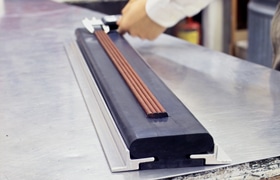Inflatable Clamps & Actuators
We Develop and Manufacture Inflatable Clamps and Actuators for any Application
Why Choose Inflatable Clamps and Actuators
Inflatable actuators are used to push a secondary compression seal (or fixture) into place, thereby creating a uniform, reliable seal. In a typical application, the inflatable actuator pushes a seal made of a harder material (e.g. PTFE) which then seals against a rotating piece of equipment. During shutdown, the air is removed from the inflatable actuator, making change out of the entire system much easier. Much like inflatable seals and clamps, an inflatable actuator will account for sealing gap variation which often occurs on larger equipment. Inflatable actuators have also been used to push trays holding medical tools against a mating compression seal during delicate cleaning operations. This ensures a quick and effective seal every time.
Inflatable clamps provide uniformed controlled pressure to firmly bond or laminate pieces together. They can also hold pieces in place during machining/cutting operations. Unlike standard piston-style clamps, an inflatable bladder clamp gives you more design flexibility and allows for:

Typical Inflatable Clamping Applications
Our inflatable bladder clamps are being used today in many unique applications, including:
Have a clamping or actuating challenge?
Custom and Standard Actuators for any Application
Pneuma-Seal is our flagship line of Inflatable seals, clamps and actuators. Choose from over 70 profile designs (both extruded, non-reinforced and fabric reinforced) along with thousands of configuration and air connector options. If you need a completely custom actuator or a larger size (i.e. over 20 LF), then check out our Pneuma-Seal line of custom inflatable seals, clamps, and actuators.
Q Inflatable Seals is our new line of build-your-own inflatable seals, clamps and actuators. With the Q design process, specify the actuator you need, and then our program helps you select the appropriate configuration, material, profile, and air connector style. Once submitted, we will send you a quote for the actuator within 24 hours. It’s a great way to get a fully customized actuator designed for your needs. Learn more or start designing your own custom Q inflatable actuator right now.
For more information regarding proper clamp designs, please review our Designing with Inflatable Seals Guide, or jump into our Technical Information section for further details.
Design Engineers: Read our Design Guide
To gain a better understanding of the processes, materials and technical considerations involved in the design and manufacture of custom-molded rubber, read through our Engineer Design Guide. This comprehensive design tool details both rubber and plastic design issues including a materials overview and prototype mold design considerations.
